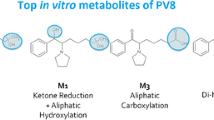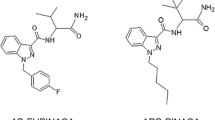Abstract
Acetazolamide (ACZ) is a carbonic anhydrase inhibitor prescribed for the treatment of various pathologies. It is also used in doping and is prohibited in and out of sportive competitions. ACZ was reported not to undergo metabolization. However, the detection of ACZ metabolites may be critical for documenting ACZ use. We aimed to further investigate ACZ metabolic fate in humans. ACZ putative metabolites were generated in silico to assist in metabolite identification. ACZ was incubated with primary human hepatocytes to identify in vitro metabolites (10 µmol/l ACZ and 106 cells/ml), and urine and plasma samples from patients receiving a single 5.0 mg/kg BW PO ACZ dose were analyzed to confirm the results in vivo. Analyses were performed with reversed-phase liquid chromatography and hydrophilic interaction chromatography coupled with high-resolution tandem mass spectrometry (RPLC-HRMS/MS and HILIC-HRMS/MS, respectively). Data were screened with a software-assisted targeted/untargeted workflow. ACZ was quantified in urine samples with creatinine normalization. We identified two metabolites in hepatocyte incubations and three additional metabolites in urine and plasma. Major transformations included cysteine conjugation, glucuronidation, and N-acetylation. All metabolites were detected in plasma, 1.5 h after intake. Major metabolites were detected in urine from 0.25 to 24 h (last collection) after intake. As opposed to the literature, ACZ does undergo metabolization in humans. We propose ACZ, ACZ-Cys, and N-acetyl-ACZ in urine, and ACZ and N-acetyl-ACZ in plasma as specific biomarkers of ACZ intake in doping.




Similar content being viewed by others
References
Acar S, Sanli S, Oztosun C et al (2021) Pharmacologic and interventional paradigms of diuretic resistance in congestive heart failure: a narrative review. Int Urol Nephrol 53:1839–1849
Cadwallader AB, de la Torre X, Tieri A, Botrè F (2010) The abuse of diuretics as performance-enhancing drugs and masking agents in sport doping: pharmacology, toxicology and analysis. Br J Pharmacol 161:16
Carlier J, Diao X, Scheidweiler KB, Huestis MA (2017) Distinguishing intake of new synthetic cannabinoids ADB-PINACA and 5F-ADB-PINACA with human hepatocyte metabolites and high-resolution mass spectrometry. Clin Chem 63:1008–1021
Carlier J, Diao X, Huestis MA (2018) Synthetic cannabinoid BB-22 (QUCHIC): human hepatocytes metabolism with liquid chromatography-high resolution mass spectrometry detection. J Pharm Biomed Anal 157:27–35
Carlier J, Diao X, Giorgetti R et al (2021) Pyrrolidinyl synthetic cathinones α-PHP and 4F-α-PVP metabolite profiling using human hepatocyte incubations. Int J Mol Sci 22:1–17
ChemSpider—search and share chemistry. http://www.chemspider.com. Accessed 10 Feb 2022
Cvetkovic RS, Perry CM (2003) Brinzolamide: a review of its use in the management of primary open-angle glaucoma and ocular hypertension. Drugs Aging 20:919–947
De Bruyn KC, Šícho M, Mazzolari A, Kirchmair J (2021) GLORYx: prediction of the metabolites resulting from phase 1 and phase 2 biotransformations of xenobiotics. Chem Res Toxicol 34:286–299
Delbeke FT, Debackere M (1985) The influence of diuretics on the excretion and metabolism of doping agents—I. Mephentermine. J Pharm Biomed Anal 3:141–148
Delbeke FT, Debackere M (1986a) The influence of diuretics on the excretion and metabolism of doping agents II. Phentermine—PubMed. Arzneimittelforschung 36:134–137
Delbeke FT, Debackere M (1986b) The influence of diuretics on the excretion and metabolism of doping agents III. Etilamfetamine. Arzneimittelforschung 36:1413–1416
Delbeke FT, Debackere M (1988) The influence of diuretics on the excretion and metabolism of doping agents part iv—caffeine. Biopharm Drug Dispos 9:137–145
Delbeke FT, Debackere M (1991a) The influence of diuretics on the excretion and metabolism of doping agents - V. Dimefline J Pharm Biomed Anal 9:23–28
Delbeke FT, Debackere M (1991b) The influence of diuretics on the excretion and metabolism of doping agents: Part VI. Pseudoephedrine. Biopharm Drug Dispos 12:37–48
Di Trana A, Brunetti P, Giorgetti R et al (2021) In silico prediction, LC-HRMS/MS analysis, and targeted/untargeted data-mining workflow for the profiling of phenylfentanyl in vitro metabolites. Talanta 235:122740
Diao X, Carlier J, Zhu M et al (2017a) In vitro and in vivo human metabolism of a new synthetic cannabinoid NM-2201 (CBL-2201). Forensic Toxicol 35:20–32
Diao X, Carlier J, Zhu M, Huestis MA (2017b) Human hepatocyte metabolism of novel synthetic cannabinoids MN-18 and its 5-fluoro analog 5F-MN-18. Clin Chem 63:1753–1763
Diao X, Carlier J, Zhu M, Huestis MA (2018) Metabolism of the new synthetic cannabinoid EG-018 in human hepatocytes by high-resolution mass spectrometry. Forensic Toxicol 36:304–312
Easterbrook J, Lu C, Sakai Y, Li AP (2001) Effects of organic solvents on the activities of cytochrome P450 isoforms, UDP-dependent glucuronyl transferase, and phenol sulfotransferase in human hepatocytes. Drug Metab Dispos 29:141–144
García-Galán MJ, Díaz-Cruz S, Barcelo D (2008) Identification and determination of metabolites and degradation products of sulfonamide antibiotics: advanced MS analysis of metabolites and degradation products—II. TrAC Trends Anal Chem 27:1008–1022
Goodman LS, Gilman A (1975) Pharmacological basis of therapeutics, 5th edn. Macmillan, New York City
Hampson AJ, Babalonis S, Lofwall MR et al (2016) A pharmacokinetic study examining acetazolamide as a novel adherence marker for clinical trials. J Clin Psychopharmacol 36:324–332
Hampson AJ, Schroeder JR, Ellefsen KN et al (2020) Subtherapeutic acetazolamide doses as a noninvasive method for assessing medication adherence. Clin Pharmacol Ther 108:1203–1212
Keller BO, Sui J, Young AB, Whittal RM (2008) Interferences and contaminants encountered in modern mass spectrometry. Anal Chim Acta 627:71–81
Kintz P, Gheddar L, Ameline A, Raul J (2021) Hair testing for acetazolamide as an evidence of the use of a contaminated dietary supplement. Drug Test Anal 13:1584–1588
Kishida K, Yamamura N, Iwai Y et al (2011) The metabolism of methazolamide—identification of metabolites in guinea pig urine. Drug Metab Lett 5:45–54
Kotronoulas A, Gomez-Gómez À, Fabregat A et al (2018) Evaluation of markers out of the steroid profile for the screening of testosterone misuse. Part II: intramuscular administration. Drug Test Anal 10:849–859
Lo Faro AF, Tini A, Gottardi M et al (2021) Development and validation of a fast ultra high-performance liquid chromatography tandem mass spectrometry (UHPLC-MS/MS) method for determining carbonic anhydrase inhibitors and their metabolites in urine and hair. Drug Test Anal 13:1552–1560
Maren TH (1967) Carbonic anhydrase: chemistry, physiology, and inhibition. Physiol Rev 47:595–781
Maren TH (1974) Chemistry of the renal reabsorption of bicarbonate. Can J Physiol Pharmacol 52:1041–1050
Martens-Lobenhoffer J, Banditt P (2002) Clinical pharmacokinetics of dorzolamide. Clin Pharmacokinet 41:197–205
Meyer MR, Maurer HH (2012) Current applications of high-resolution mass spectrometry in drug metabolism studies. Anal Bioanal Chem 403:1221–1231
mzCloud—Advanced mass spectral database. https://www.mzcloud.org. Accessed 10 Feb 2022
Odlind B (1984) Site and mechanism of the action of diuretics. Acta Pharmacol Toxicol (copenh) 54(Suppl 1):5–15
Putz M, Piper T, Thevis M (2020) Identification of trenbolone metabolites using hydrogen isotope ratio mass spectrometry and liquid chromatography/high accuracy/high resolution mass spectrometry for doping control analysis. Front Chem 8:435
Sasabe T, Maeda S, Kishida K et al (2017) The metabolism of methazolamide in immortalized human keratinocytes, HaCaT cells. Drug Metab Lett 10:295–305
Scozzafava A, Supuran CT (2014) Glaucoma and the applications of carbonic anhydrase inhibitors. Subcell Biochem 75:349–359
Statland JM, Fontaine B, Hanna MG et al (2018) Review of the diagnosis and treatment of periodic paralysis. Muscle Nerve 57:522–530
Stork C, Embruch G, Šícho M et al (2020) NERDD: a web portal providing access to in silico tools for drug discovery. Bioinformatics 36:1291–1292
Supuran CT (2015) Acetazolamide for the treatment of idiopathic intracranial hypertension. Expert Rev Neurother 15:851–856
Supuran CT, Scozzafava A (2000) Carbonic anhydrase inhibitors and their therapeutic potential. Expert Opin Ther Pat 10:575–600
Supuran CT, Scozzafava A, Casini A (2003) Carbonic anhydrase inhibitors. Med Res Rev 23:146–189
Swortwood MJ, Carlier J, Ellefsen KN et al (2016) In vitro, in vivo and in silico metabolic profiling of α-pyrrolidinopentiothiophenone, a novel thiophene stimulant. Bioanalysis 8:65–82
Teslenko I, Watson CJW, Xia Z et al (2021) Characterization of cytosolic glutathione S-transferases involved in the metabolism of the aromatase inhibitor, exemestane. Drug Metab Dispos 49:1047–1055
Williamson J, Oakeshott P, Dallimore J (2018) Altitude sickness and acetazolamide. BMJ 361:k2153
World Anti-Doping Agency (WADA) (2011) 2010 Adverse analytical findings and atypical findings reported by accredited laboratories. https://www.wada-ama.org/sites/default/files/resources/files/WADA_2010_Laboratory_Statistics_Report.pdf. Accessed 10 Feb 2022
World Anti-Doping Agency (WADA) (2012) 2011 laboratory testing figures reported by accredited laboratories. https://www.wada-ama.org/sites/default/files/resources/files/WADA-2011-Laboratory-Testing-Figures.pdf. Accessed 10 Feb 2022
World Anti-Doping Agency (WADA) (2013) 2012 anti-doping testing figures report. https://www.wada-ama.org/sites/default/files/resources/files/WADA-2012-Anti-Doping-Testing-Figures-Report-EN.pdf. Accessed 10 Feb 2022
World Anti-Doping Agency (WADA) (2014) 2013 anti-doping testing figures report. https://www.wada-ama.org/sites/default/files/wada_2013_anti-doping_testing_figures_report_en.pdf. Accessed 10 Feb 2022
World Anti-Doping Agency (WADA) (2015) 2014 anti-doping testing figures report. https://www.wada-ama.org/sites/default/files/wada_2014_anti-doping-testing-figures_full-report_en.pdf. Accessed 10 Feb 2022
World Anti-Doping Agency (WADA) (2016) 2015 anti-doping testing figures. https://www.wada-ama.org/sites/default/files/resources/files/2015_wada_anti-doping_testing_figures_report_0.pdf. Accessed 10 Feb 2022
World Anti-Doping Agency (WADA) (2017) 2016 anti-doping testing figures. https://www.wada-ama.org/sites/default/files/resources/files/2016_anti-doping_testing_figures.pdf. Accessed 10 Feb 2022
World Anti-Doping Agency (WADA) (2018) 2017 anti-doping testing figures. https://www.wada-ama.org/sites/default/files/resources/files/2017_anti-doping_testing_figures_en_0.pdf. Accessed 10 Feb 2022
World Anti-Doping Agency (WADA) (2019) 2018 anti-doping testing figures. https://www.wada-ama.org/sites/default/files/resources/files/2018_testing_figures_report.pdf. Accessed 10 Feb 2022
World Anti-Doping Agency (WADA) (2020) 2019 anti-doping testing figures. https://www.wada-ama.org/sites/default/files/resources/files/2019_anti-doping_testing_figures_en.pdf. Accessed 10 Feb 2022
World Anti-Doping Agency (WADA) (2021a) World anti-doping code - International standard prohibited list. https://www.wada-ama.org/sites/default/files/resources/files/2021list_en.pdf. Accessed 10 Feb 2022
World Anti-Doping Agency (WADA) (2021b) WADA publishes stakeholder notices regarding potential contamination cases related to meat and diuretics. https://www.wada-ama.org/en/media/news/2021b-06/wada-publishes-stakeholder-notices-regarding-potential-contamination-cases. Accessed 10 Feb 2022
Acknowledgements
This research was funded by the Italian Ministry of Health (“Ministero della Salute”), grant number I34I19001520001 as CUP.
Author information
Authors and Affiliations
Corresponding author
Ethics declarations
Conflict of interest
The authors declare no conflict of interest. The funders had no role in the design of the study; in the collection, analyses, or interpretation of data; in the writing of the manuscript, or in the decision to publish the results.
Ethical standards
The study was conducted according to the guidelines of the Declaration of Helsinki, and approved by the Institutional Ethics Committee of CERM (263/2020, October 1, 2020). Informed consent was obtained from all patients involved in the study.
Additional information
Publisher's Note
Springer Nature remains neutral with regard to jurisdictional claims in published maps and institutional affiliations.
Supplementary Information
Below is the link to the electronic supplementary material.
Rights and permissions
About this article
Cite this article
Busardò, F.P., Lo Faro, A.F., Sirignano, A. et al. In silico, in vitro, and in vivo human metabolism of acetazolamide, a carbonic anhydrase inhibitor and common “diuretic and masking agent” in doping. Arch Toxicol 96, 1989–2001 (2022). https://doi.org/10.1007/s00204-022-03289-z
Received:
Accepted:
Published:
Issue Date:
DOI: https://doi.org/10.1007/s00204-022-03289-z




